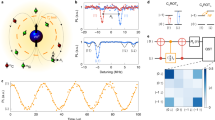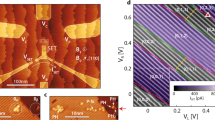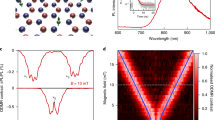Abstract
A prerequisite for exploiting spins for quantum data storage and processing is long spin coherence times. Phosphorus dopants in silicon (Si:P) have been favoured1,2,3,4,5,6,7,8,9,10 as hosts for such spins because of measured electron spin coherence times (T2) longer than any other electron spin in the solid state: 14 ms at 7 K with isotopically purified silicon11. Heavier impurities such as bismuth in silicon (Si:Bi) could be used in conjunction with Si:P for quantum information proposals that require two separately addressable spin species12,13,14,15. However, the question of whether the incorporation of the much less soluble Bi into Si leads to defect species that destroy coherence has not been addressed. Here we show that schemes involving Si:Bi are indeed feasible as the electron spin coherence time T2 is at least as long as for Si:P with non-isotopically purified silicon. We polarized the Si:Bi electrons and hyperpolarized the I=9/2 nuclear spin of 209Bi, manipulating both with pulsed magnetic resonance. The larger nuclear spin means that a Si:Bi dopant provides a 20-dimensional Hilbert space rather than the four-dimensional Hilbert space of an I=1/2 Si:P dopant.
This is a preview of subscription content, access via your institution
Access options
Subscribe to this journal
Receive 12 print issues and online access
$259.00 per year
only $21.58 per issue
Buy this article
- Purchase on Springer Link
- Instant access to full article PDF
Prices may be subject to local taxes which are calculated during checkout




Similar content being viewed by others
References
Kane, B. E. A silicon-based nuclear spin quantum computer. Nature 393, 133–137 (1998).
Schofield, S. R. et al. Atomically precise placement of single dopants in Si. Phys. Rev. Lett. 91, 136104 (2003).
Morton, J. J. L. et al. Solid-state quantum memory using the P-31 nuclear spin. Nature 455, 1085–1088 (2008).
Morley, G. W. et al. Long-lived spin coherence in silicon with an electrical spin trap readout. Phys. Rev. Lett. 101, 207602 (2008).
Greenland, P. T. et al. Coherent control of Rydberg states in silicon. Nature 465, 1057–1061 (2010).
McCamey, D. R., van Tol, J., Morley, G. W. & Boehme, C. Fast nuclear spin hyperpolarization of phosphorus in silicon. Phys. Rev. Lett. 102, 027601 (2009).
van Tol, J. et al. High-field phenomena of qubits. Appl. Magn. Res. 36, 259–268 (2009).
Tyryshkin, A. M. et al. Coherence of spin qubits in silicon. J. Phys. Condens. Matter 18, S783–S794 (2006).
Morello, A. et al. Single-shot readout of an electron spin in silicon. Preprint at http://arxiv.org/abs/1003.2679 (2010).
Yang, A. et al. Subsecond hyperpolarization of the nuclear and electron spins of phosphorus in silicon by optical pumping of exciton transitions. Phys. Rev. Lett. 102, 257401 (2009).
Tyryshkin, A. M., Lyon, S. A., Astashkin, A. V. & Raitsimring, A. M. Electron spin relaxation times of phosphorus donors in silicon. Phys. Rev. B 68, 193207 (2003).
Benjamin, S. C. Quantum computing without local control of qubit–qubit interactions. Phys. Rev. Lett. 88, 017904 (2002).
Stoneham, A. M., Fisher, A. J. & Greenland, P. T. Optically driven silicon-based quantum gates with potential for high-temperature operation. J. Phys. Condens. Matter 15, L447–L451 (2003).
Benjamin, S. C. & Bose, S. Quantum computing with an always-on Heisenberg interaction. Phys. Rev. Lett. 90, 247901 (2003).
Stoneham, A. M., Harker, A. H. & Morley, G. W. Could one make a diamond-based quantum computer? J. Phys. Condens. Matter 21, 364222 (2009).
Feher, G. Electron spin resonance experiments on donors in silicon. I. Electronic structure of donors by the electron nuclear double resonance technique. Phys. Rev. 114, 1219–1244 (1959).
Pajot, B. & Stoneham, A. M. A spectroscopic investigation of the lattice distortion at substitutional sites for group V and group VI donors in silicon. J. Phys. C 20, 5241–5252 (1987).
Morley, G. W., Brunel, L-C. & van Tol, J. A multifrequency high-field pulsed electron paramagnetic resonance/electron-nuclear double resonance spectrometer. Rev. Sci. Instrum. 79, 064703 (2008).
van Tol, J., Brunel, L. C. & Wylde, R. J. A quasioptical transient electron spin resonance spectrometer operating at 120 and 240 GHz. Rev. Sci. Instrum. 76, 074101 (2005).
Morley, G. W. et al. Efficient dynamic nuclear polarization at high magnetic fields. Phys. Rev. Lett. 98, 220501 (2007).
Lampel, G. Nuclear dynamic polarization by optical electronic saturation and optical pumping in semiconductors. Phys. Rev. Lett. 20, 491–493 (1968).
Sekiguchi, T. et al. Hyperfine structure and nuclear hyperpolarization observed in the bound exciton luminescence of Bi donors in natural Si. Phys. Rev. Lett. 104, 137402 (2010).
Schweiger, A. & Jeschke, G. Principles of Pulse Electron Paramagnetic Resonance (Oxford Univ. Press, 2001).
Castner, T. G. Direct measurement of the valley-orbit splitting of shallow donors in silicon. Phys. Rev. Lett. 8, 13–15 (1962).
Castner, T. G. Orbach spin-lattice relaxation of shallow donors in silicon. Phys. Rev. 155, 816–825 (1967).
Feher, G. & Gere, E. A. Electron spin resonance experiments on donors in silicon II. Electron spin relaxation effects. Phys. Rev. 114, 1245–1256 (1959).
Du, J. F. et al. Preserving electron spin coherence in solids by optimal dynamical decoupling. Nature 461, 1265–1268 (2009).
Li, D. et al. Intrinsic origin of spin echoes in dipolar solids generated by strong π pulses. Phys. Rev. B 77, 214306 (2008).
Balasubramanian, G. et al. Ultralong spin coherence time in isotopically engineered diamond. Nature Mater. 8, 383–387 (2009).
Tyryshkin, A. M. & Lyon, S. A. Data presented at the Silicon Qubit Workshop 24–25 August (Univ. California, sponsored by Lawrence Berkeley National Laboratory and Sandia National Laboratory, 2009).
Mohammadi, H. M., Morley, G. W. & Monteiro, T. S. Bismuth qubits in silicon: the role of EPR cancellation resonances. Phys. Rev. Lett. (in the press); preprint at http://arxiv.org/abs/1004.3475 (2010).
George, R. E. et al. Electron spin coherence and electron nuclear double resonance of Bi donors in natural Si. Phys. Rev. Lett. (in the press); preprint at http://arxiv.org/abs/1004.0340 (2010).
Acknowledgements
We thank B. Pajot for supplying the Si:Bi samples. Our research was supported by the RCUK Basic Technologies programme, the EPSRC programme grant COMPASSS and a Wolfson Royal Society Research Merit Award. The National High Magnetic Field Laboratory is supported by NSF Cooperative Agreement No. DMR-0654118, and by the State of Florida. G.W.M. is supported by an 1851 Research Fellowship.
Author information
Authors and Affiliations
Contributions
G.W.M., M.W. and C.W.M.K. carried out the experiments at 9.7 GHz; G.W.M. and J.v.T. carried out the experiments at 240 GHz. G.W.M. and P.T.G. carried out the simulations. G.W.M. analysed the data, which were interpreted by G.W.M., A.M.S., J.v.T., C.W.M.K. and G.A. The Letter was written by G.W.M., A.M.S., J.v.T., C.W.M.K. and G.A.
Corresponding author
Ethics declarations
Competing interests
The authors declare no competing financial interests.
Supplementary information
Supplementary Information
Supplementary Information (PDF 216 kb)
Rights and permissions
About this article
Cite this article
Morley, G., Warner, M., Stoneham, A. et al. The initialization and manipulation of quantum information stored in silicon by bismuth dopants. Nature Mater 9, 725–729 (2010). https://doi.org/10.1038/nmat2828
Received:
Accepted:
Published:
Issue Date:
DOI: https://doi.org/10.1038/nmat2828
This article is cited by
-
Navigating the 16-dimensional Hilbert space of a high-spin donor qudit with electric and magnetic fields
Nature Communications (2024)
-
Electrically controlled nuclear polarization of individual atoms
Nature Nanotechnology (2018)
-
Quantum decoherence dynamics of divacancy spins in silicon carbide
Nature Communications (2016)
-
Controlling spin relaxation with a cavity
Nature (2016)
-
Optical patterning of trapped charge in nitrogen-doped diamond
Nature Communications (2016)



